Yams for baby food
Yam - First Foods for Babies
When can babies eat yams?
Yams, when soft and fully cooked, may be introduced as soon as baby is ready for solids, which is usually around 6 months of age. Note: This page is about the true yam. See our sweet potato page for information about the smaller, sweeter tuber.
Need ideas for the best first foods for babies? See our guides
Where do yams come from?
Yams are tubers with a rough, scaly brown skin and hearty, starchy flesh that originated in Asia and Africa. Sometimes other roots like oca and taro are called yam, but they are botanically distinct from the true yam, which was first cultivated some 18,000 years ago in Africa. Yams can be boiled, mashed, fried, and even made into a flour, and they play a vital role in African and Caribbean cuisines, from rich stews to the celebratory dish called oto or eto, a puree made with yams or plantains and served with hard-boiled eggs in Ghanaian homes and festivals.
In the United States and some other regions, sweet potatoes are often called yams, but the two are from completely different botanical families. So why the confusion? According to Maricel Presilla, author of Gran Cocina Latina, the answer goes back to Portuguese voyages to Africa, where the West African term nyami (yam) was appropriated for similar-looking root vegetables. The relationship between yam and sweet potato also connects to the Middle Passage: enslaved people from Africa ate yams on the journey from their homelands across the Atlantic, and then used the term to refer to the sweet potatoes growing in the Americas. 1
Are yams healthy for babies?
Yes. Yams are dense in carbohydrates and offer good amounts of fiber. They are an excellent source of potassium, a good source of B-vitamins, including B6, and also offer some vitamin C. Yams also contain many compounds that benefit the body in a wide range of ways, such as providing antioxidants (especially purple yams) and supporting the immune system.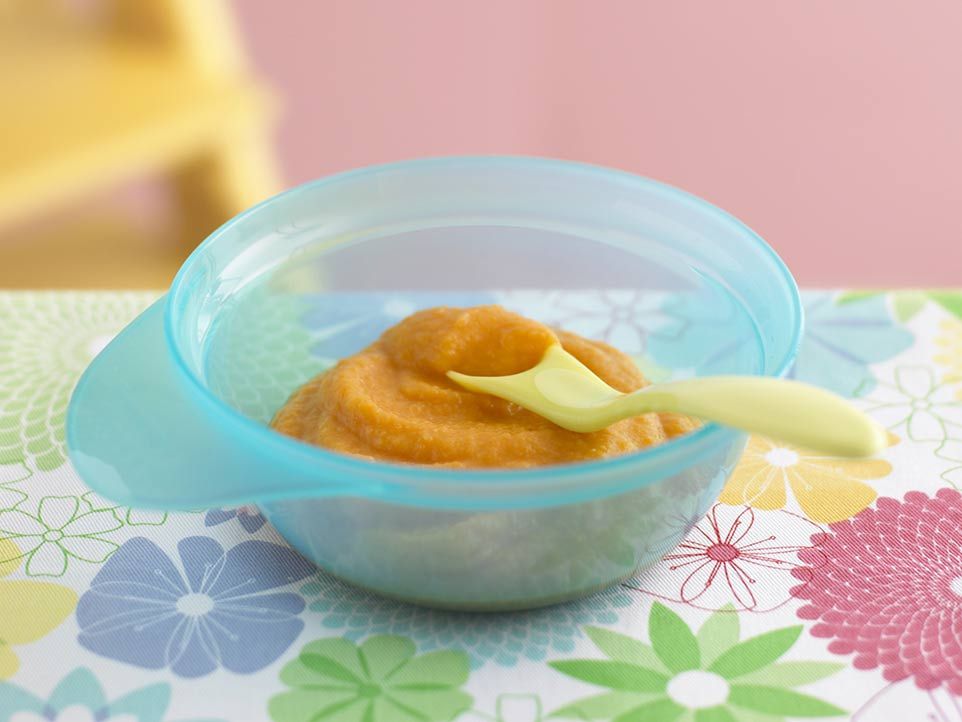 2 As with cassava, wheat, and other staple foods worldwide that are made into flours, yam flour may be fortified with added nutrients, such as protein, vitamins A and C, calcium, iron, or zinc – which are essential for a growing baby. If you’re interested in fortified yam flour, just check the nutrition label to see if your yam flour has had these nutrients added.3 4
2 As with cassava, wheat, and other staple foods worldwide that are made into flours, yam flour may be fortified with added nutrients, such as protein, vitamins A and C, calcium, iron, or zinc – which are essential for a growing baby. If you’re interested in fortified yam flour, just check the nutrition label to see if your yam flour has had these nutrients added.3 4
When serving yams to baby, keep in mind:
- Yams, like some other food crops, can contain trace amounts of heavy metals (such as lead and arsenic) from the soil as a result of industrial pollution and contamination leaching into the ground over many years, including some mining locations in Africa.5 6 Even organically grown produce may contain heavy metals.7 As long as you offer baby a wide variety of foods without relying too heavily on foods that tend to be high in heavy metals, like rice, yam, and sweet potato, you need not worry.8
- Always serve yam that has been fully cooked.
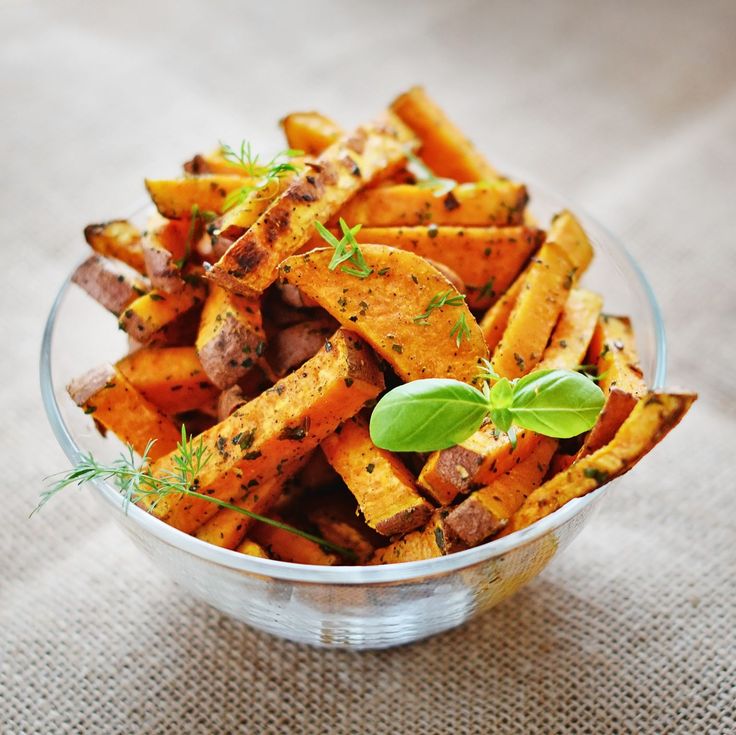 In addition to being a choking hazard, raw yam sometimes contains cyanogens as well as a group of plant compounds sometimes called “anti-nutrients”. Many of these plant compounds break down during the washing, soaking, and boiling or roasting of yams and are generally harmless in healthy people when consumed as part of a balanced diet.9 Certain antinutrients may even offer health benefits, such as antioxidant and anti-cancer properties.10 Avoid wild bitter yam, which can be toxic.11
In addition to being a choking hazard, raw yam sometimes contains cyanogens as well as a group of plant compounds sometimes called “anti-nutrients”. Many of these plant compounds break down during the washing, soaking, and boiling or roasting of yams and are generally harmless in healthy people when consumed as part of a balanced diet.9 Certain antinutrients may even offer health benefits, such as antioxidant and anti-cancer properties.10 Avoid wild bitter yam, which can be toxic.11
★Tip: Yams love the dark! Storing yams in a cool, dark, and well-aerated area will allow them to maintain their nutritional value for about 2 weeks. Avoid storing them in the fridge or in a container or wrapping yams, as that can encourage spoiling.
Are yams a common choking hazard for babies?
If cooked to a soft consistency, yams should not be a choking hazard for babies. To minimize the risk, make sure the yam is fully cooked and soft before serving. As always, make sure you create a safe eating environment and stay within an arm’s reach of baby at mealtime. For more information on choking, visit our section on gagging and choking and familiarize yourself with the list of common choking hazards.
As always, make sure you create a safe eating environment and stay within an arm’s reach of baby at mealtime. For more information on choking, visit our section on gagging and choking and familiarize yourself with the list of common choking hazards.
Are yams a common allergen?
No. Yams are not a common allergen, although yam allergies have been reported.12 13 14 In theory, an individual can be allergic to any food. Oral Allergy Syndrome (also called pollen food allergy syndrome) to yam is rare, but has been reported.15 Oral Allergy Syndrome typically results in short-lived itching in the mouth and is unlikely to result in a dangerous reaction. Cooking yam can minimize the reaction.16 17
As you would when introducing any new food, start by offering a small quantity for the first few servings. If there is no adverse reaction, gradually increase the quantity over future meals.
Recommended Guide: Introducing Allergens to Babies
How do you prepare yams for babies with baby-led weaning?
Every baby develops on their own timeline, and the suggestions on how to cut or prepare particular foods are generalizations for a broad audience. Your child is an individual and may have needs or considerations beyond generally accepted practices. In determining the recommendations for size and shape of foods, we use the best available scientific information regarding gross, fine, and oral motor development to minimize choking risk. The preparation suggestions we offer are for informational purposes only and are not a substitute for child-specific, one-on-one advice from your pediatric medical or health professional or provider. It is impossible to fully eliminate all risk of a baby or child choking on any liquid, puree, or food. We advise you to follow all safety protocols we suggest to create a safe eating environment and to make educated choices for your child regarding their specific needs. Never disregard professional medical advice or delay in seeking it because of something you have read or seen here.
Your child is an individual and may have needs or considerations beyond generally accepted practices. In determining the recommendations for size and shape of foods, we use the best available scientific information regarding gross, fine, and oral motor development to minimize choking risk. The preparation suggestions we offer are for informational purposes only and are not a substitute for child-specific, one-on-one advice from your pediatric medical or health professional or provider. It is impossible to fully eliminate all risk of a baby or child choking on any liquid, puree, or food. We advise you to follow all safety protocols we suggest to create a safe eating environment and to make educated choices for your child regarding their specific needs. Never disregard professional medical advice or delay in seeking it because of something you have read or seen here.
6 to 9 months old: Cook yam until soft (at least pierceable with a fork), then cut it into spears, lightly mash it, or puree it. Either way, yam can be served as finger food for baby to scoop up with hands. You can also season the yam with a healthy fat like butter, oil, or yogurt to add nutrition and a pinch of your favorite spice to add flavor. If you’d like to encourage use of a utensil, pre-load a spoon and rest it next to the food for baby to try to pick up—or pass it in the air for baby to grab.
Either way, yam can be served as finger food for baby to scoop up with hands. You can also season the yam with a healthy fat like butter, oil, or yogurt to add nutrition and a pinch of your favorite spice to add flavor. If you’d like to encourage use of a utensil, pre-load a spoon and rest it next to the food for baby to try to pick up—or pass it in the air for baby to grab.
9 to 12 months old: At this age, babies develop a pincer grasp (where the thumb and forefinger meet), which enables them to pick up smaller pieces of food. When you see signs of this development happening, try serving bite-sized pieces of cooked yam for baby to try to pick up. You can also continue to offer cooked yam spears for practice with biting and managing bigger pieces of food. Consider serving thinner slices of cooked yam with the skin. Babies often chew on the skin and spit it out, and while this seems like waste, building familiarity with skin can help encourage a child to eat fruits and vegetables with the skin later in life. It also encourages the development of grinding skills, which will be useful soon with the newly popped molars in toddlerhood! The act of chewing and spitting the skin also helps develop oral-motor skills. Learning to spit is actually quite important. Of course, you may continue serving mashed yam for baby to eat with hands or a utensil if it would make you feel more comfortable.
It also encourages the development of grinding skills, which will be useful soon with the newly popped molars in toddlerhood! The act of chewing and spitting the skin also helps develop oral-motor skills. Learning to spit is actually quite important. Of course, you may continue serving mashed yam for baby to eat with hands or a utensil if it would make you feel more comfortable.
12 to 24 months old: Continue serving cooked yam on its own or as part of other family dishes. You can also take this opportunity to encourage utensil practice: offer bite-sized pieces of cooked yam along with a fork and help show how it’s done by pre-loading the fork for baby to pick up independently. You can also try spearing the yam while making a sound (boink!) to make it fun to use the utensil. If the child is not interested in using a fork or spoon, keep in mind that using utensils can be exhausting for new eaters, and many children toggle back and forth between feeding themselves with their fingers and utensils.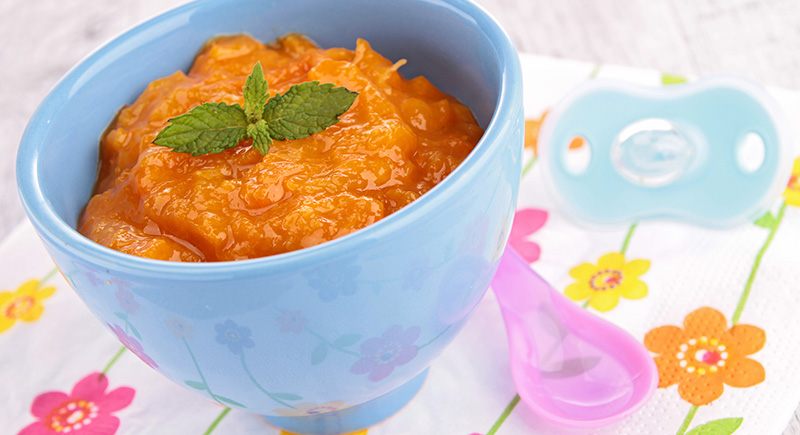 Try not to apply too much pressure—consistent and accurate utensil use will come in due time—probably between 18 and 24 months of age.
Try not to apply too much pressure—consistent and accurate utensil use will come in due time—probably between 18 and 24 months of age.
Our Nutrient Cheat Sheet is a quick reference to all the nutrients babies need.
Recipe: Mashed Yam and Onions Inspired by Eto
- Yield: 3 cups (500 grams)
- Cook Time: 30 minutes
- Age: 6 months+
Ingredients
- 1 yam
- 1 small onion
- 1 small bell pepper (optional)
- 2 tablespoons (30 milliliters) palm oil, avocado oil, or olive oil
- 2 tablespoons (32 grams) smooth peanut butter (no salt added)
- 1 ripe avocado (optional)
- 1 large hard-boiled egg per person (optional)
This recipe contains common allergens: egg and peanut. Only serve to a child after these allergens have been safely introduced.
Directions
- Peel the yam, discarding the skin. Chop the yam into cubes.
- Bring a pot of water to a boil. Add the yams.
 Cook until soft, about 15 minutes. Drain.
Cook until soft, about 15 minutes. Drain. - Scoop 2 cups of chopped yam into a mixing bowl. Store any extra yam in an air-tight container in the freezer for a future meal.
- Prepare the remaining ingredients while the chopped yam is cooking. First, peel and finely chop the onion, discarding the skin. If you are using the bell pepper, wash and halve the pepper, then discard the stem, seeds, and pith. Finely chop the flesh.
- Heat the oil in a skillet set on medium-high heat. When the oil shimmers, add the onion and pepper. Stir to coat. Cook, stirring occasionally, until the onion has turned golden and the pepper has softened, about 10 minutes.
- Transfer the onion, pepper, and oil to the bowl with the yam. Add the peanut butter. Mash to form a paste. A little texture is okay as long as there are no clumps of peanut butter.
- Scoop some of the mashed yam and onions into the child’s bowl. Exact serving size is variable. Let a child’s appetite determine how much is eaten.

- In Ghana, etor is often served with a hard-boiled egg during celebratory meals sometimes with avocado for extra flavor and nutrition. If you like, top the child’s mashed yam and onions with a hard-boiled egg cut into age-appropriate sizes and serve with some sliced avocado on the side.
- Season the mashed yam and onions for adults and older children with salt to taste.
- Serve the mashed yam and onion as finger food. If you’d like to encourage use of a utensil, simply preload an age-appropriate utensil and rest it next to the food for the child to try to pick up. Alternatively, pass the preloaded utensil in the air for the child to grab.
To Store: Mashed Yam and Onion keeps in an air-tight container in the fridge for 3 days.
★ Tip: Like plantain and potato, cooked yam stiffens as it cools. To serve leftovers, simply reheat with a little water or milk and stir to combine, adding more liquid as needed to reach the desired consistency.
Flavor Pairings
Yams hearty starch pairs well with egg, garlic, ginger, onion, peanut, plantain.
Reviewed by
J. Truppi, MSN, CNS
V. Kalami, MNSP, RD, CSP
K. Grenawitzke, OTD, OTR/L, SCFES, IBCLC, CNT
S. Bajowala, MD, FAAAAI. Board-Certified Allergist & Immunologist (allergy section)
R. Ruiz, MD, FAAP. Board-Certified General Pediatrician & Pediatric Gastroenterologist
- Science Reference Section, Library of Congress. (2019). What is the difference between sweet potatoes and yams? The Library of Congress.https://loc.gov/everyday-mysteries/item/what-is-the-difference-between-sweet-potatoes-and-yams/?loclr=ealn
- Obidiegwu, J. E., Lyons, J. B., & Chilaka, C. A. (2020). The Dioscorea Genus (Yam)-An Appraisal of Nutritional and Therapeutic Potentials. Foods (Basel, Switzerland), 9(9), 1304. https://doi.org/10.3390/foods9091304
- Soronikpoho S., Elleingand E. F., Fatoumata C., Ernest K. Evaluation of nutritive value of yam based weaning food fortified with soy and vegetables minerals sources.
 American Journal of Food and Nutrition. 2017;5(4):126–135. doi: 10.12691/ajfn-5-4-3.https://www.researchgate.net/profile/Soronikpoho-Soro/publication/320398550_Evaluation_of_Nutritive_Value_of_Yam_Based_Weaning_Food_Fortified_With_Soy_and_Vegetables_Minerals_Sources/links/601f3bb9a6fdcc37a80b1584/Evaluation-of-Nutritive-Value-of-Yam-Based-Weaning-Food-Fortified-With-Soy-and-Vegetables-Minerals-Sources.pdf
American Journal of Food and Nutrition. 2017;5(4):126–135. doi: 10.12691/ajfn-5-4-3.https://www.researchgate.net/profile/Soronikpoho-Soro/publication/320398550_Evaluation_of_Nutritive_Value_of_Yam_Based_Weaning_Food_Fortified_With_Soy_and_Vegetables_Minerals_Sources/links/601f3bb9a6fdcc37a80b1584/Evaluation-of-Nutritive-Value-of-Yam-Based-Weaning-Food-Fortified-With-Soy-and-Vegetables-Minerals-Sources.pdf - Awoyale, W., Maziya-Dixon, B., Sanni, L. O., & Shittu, T. A. (2015). Effect of water yam (Dioscoreaalata) flour fortified with distiller’s spent grain on nutritional, chemical, and functional properties. Food science & nutrition, 4(1), 24–33. https://doi.org/10.1002/fsn3.254
- https://www.iosrjournals.org/iosr-jac/papers/vol11-issue10/Version-1/F1110013943.pdf
- https://www.ncbi.nlm.nih.gov/pmc/articles/PMC3925214/
- González N, Marquès M, Nadal M, Domingo JL. Occurrence of environmental pollutants in foodstuffs: A review of organic vs. conventional food.
 Food Chem Toxicol. 2019 Mar;125:370-375. doi: 10.1016/j.fct.2019.01.021. Epub 2019 Jan 22. PMID: 30682385.
Food Chem Toxicol. 2019 Mar;125:370-375. doi: 10.1016/j.fct.2019.01.021. Epub 2019 Jan 22. PMID: 30682385. - https://www.healthychildren.org/English/ages-stages/baby/feeding-nutrition/Pages/Metals-in-Baby-Food.aspx
- Obidiegwu, J. E., Lyons, J. B., & Chilaka, C. A. (2020). The Dioscorea Genus (Yam)-An Appraisal of Nutritional and Therapeutic Potentials. Foods (Basel, Switzerland), 9(9), 1304. https://doi.org/10.3390/foods9091304
- Obidiegwu, J. E., Lyons, J. B., & Chilaka, C. A. (2020). The Dioscorea Genus (Yam)-An Appraisal of Nutritional and Therapeutic Potentials. Foods (Basel, Switzerland), 9(9), 1304. https://doi.org/10.3390/foods9091304
- Bitter Yam. In: Natural Medicines. Available from: https://naturalmedicines.therapeuticresearch.com.
- Xu, Y. Y., & Yin, J. (2018). Identification of a thermal stable allergen in yam (Dioscorea opposita) to cause anaphylaxis. Asia Pacific allergy, 8(1), e4. https://doi.org/10.5415/apallergy.2018.
 8.e4
8.e4 - Hur, G. Y., Park, H. J., Kim, H. A., Ye, Y. M., & Park, H. S. (2008). Identification of Dioscorea batatas (sanyak) allergen as an inhalant and oral allergen. Journal of Korean medical science, 23(1), 72–76. https://doi.org/10.3346/jkms.2008.23.1.72
- Obidiegwu, J. E., Lyons, J. B., & Chilaka, C. A. (2020). The Dioscorea Genus (Yam)-An Appraisal of Nutritional and Therapeutic Potentials. Foods (Basel, Switzerland), 9(9), 1304. https://doi.org/10.3390/foods9091304
- Xu, Y. Y., & Yin, J. (2018). Identification of a thermal stable allergen in yam (Dioscorea opposita) to cause anaphylaxis. Asia Pacific allergy, 8(1), e4. https://doi.org/10.5415/apallergy.2018.8.e4
- American Academy of Allergy Asthma & Immunology. Oral Allergy Syndrome (OAS) or Pollen Fruit Syndrome (PFS). Retrieved January 9, 2020 from: https://www.aaaai.org/Tools-for-the-Public/Conditions-Library/Allergies/Oral-allergy-syndrome-(OAS)
- Sussman, G., Sussman, A., Sussman, D.
 (2010). Oral allergy syndrome. CMAJ : Canadian Medical Association journal = journal de l’Association medicale canadienne, 182(11), 1210–1211. DOI: 10.1503/cmaj.090314 . Retrieved April 1, 2021 from: https://www.cmaj.ca/content/182/11/1210
(2010). Oral allergy syndrome. CMAJ : Canadian Medical Association journal = journal de l’Association medicale canadienne, 182(11), 1210–1211. DOI: 10.1503/cmaj.090314 . Retrieved April 1, 2021 from: https://www.cmaj.ca/content/182/11/1210
Sweet Potato Puree - Healthy Little Foodies
All Posts, by Date » Special Diets » Dairy Free » Sweet Potato Puree
Jump to Recipe Print Recipe
Sweet Potato Puree is a great first food for babies. However, this delicious puree shouldn’t be limited to babies. Store some in your freezer to add extra nutrition, flavour and texture to oatmeal, sauces or baked goods.
HOW TO MAKE SWEET POTATO PUREEMaking homemade sweet potato puree is easy and you only need one ingredient – sweet potato! There are several ways to cook a sweet potato and all methods will work for pureeing but, in my opinion, roasting provides the best-tasting puree.
- Roasting – Roasting sweet potatoes produces a delicious caramelised flavour, making the puree extra delicious. Preheat oven to 200C / 400F. Pierce sweet potatoes with a fork and place on a baking tray. Bake for 45 minutes or until tender, and the skin is wrinkled. Allow to cool before peeling
- Boiling – Peel sweet potato and cut into 1.5 cm (half-inch) cubes. In a pan, bring water to a boil and add sweet potato chunks. Reduce to a simmer and cook until tender, around 15 minutes.
- Steaming – Peel and cut sweet potatoes into 1.5 cm (half-inch) cubes and steam, using a steamer, until soft.
- Food Processor – This is what I always use.
- Blender – A high-speed blender works great.
- Stick Blender – Place the cooked potato into a large jug/pan and blend until smooth
- Masher – Provides a chunkier puree
- Is your puree too thick? You can thin with a splash of milk (you can use breast or baby milk for babies)
The sweet potato is a healthy pantry staple, containing a good mix of nutrients and vitamins. Sweet potatoes are:
Sweet potatoes are:
- High in dietary fibre – Helps keep the digestive system healthy
- An excellent source of vitamin A – Essential for growth, healthy skin and for good vision.
- A good source of Vitamin C – Needed for growth and healing of wounds. It also helps in the absorption on iron.
- Vitamin B6 – Helps protein metabolism
- Potassium – Helps the heart and muscles work better
Sweet Potato Puree can be enjoyed as it is or mixed with a range of other pureed or mashed foods. Some suggestions include….
- Apples
- Pears
- Carrots
- Parsnip
- Peas
- Pumpkin
- Brown Rice
- Quinoa
- Lentils
- Chicken
- Beef
- Yoghurt
If you want to add more texture to your puree, simply mash using a masher or blend for a shorter time
OTHER GREAT USES FOR SWEET POTATO PUREE- Add to Oatmeal – For a warm and comforting start to the morning! Why not try these Sweet Potato Pie Oats.
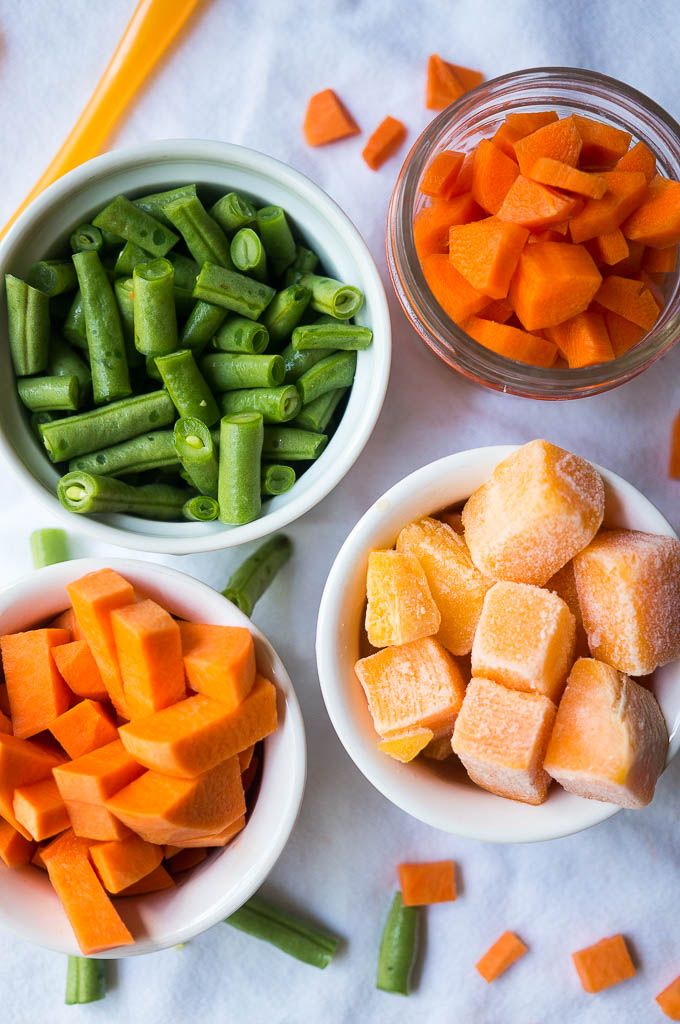
- Use in baking – Great for adding sweetness, using as a binding agent and for adding moisture to baked goods. Use in muffins, brownies and cakes.
- Add to risotto – Adds a different, yet tasty, touch to a risotto. This sweet potato and mushroom risotto looks amazing!
- Use it to make pancakes and truffles – for those kids that can’t get enough sweet potato!
- Stir into Sauces – Add some creaminess and sweetness to a range of different sauces.
- Mix into smoothies – Sweet Potato goes well with a range of smoothie ingredients and will make a smoothie ultra creamy.
- Extra Smooth Pie Topping – Great for kids with textural issues. Use it to top this Lentil and Sweet Potato Shepherds Pie
- Use as an Egg Replacement in Baking – Learn more in this egg substitution guide.

HOW TO STORE SWEET POTATO PUREE
Refrigerate- Place in an airtight container and refrigerate for up to three days.
- Spoon the puree into ice-cube trays and freeze until solid. (Freezing in ice cube trays allows you to defrost the small amounts when you need it.)
- Flexible ice cube trays work best as it is easier to pop out the frozen cubes.
- Once they’re fully frozen, quickly pop them all out and place the frozen cubes into a freezer bag or container and return to the freezer.
- Thaw in the refrigerator.
- Do not refreeze if puree has previously been frozen.
Looking for more healthy kid recipes?Sign up for my free recipe newsletter to get new family friendly recipes in your inbox each week! Find me sharing more kind-friendly inspiration on Pinterest and Instagram.
5 from 6 votes
Sweet Potato Puree
Sweet Potato Puree is a great first food for when you start weaning your baby. However, this delicious puree shouldn't be limited just to babies. Stock some in your freezer to add extra nutrition, flavour and texture to oatmeal, sauces or baked goods.
However, this delicious puree shouldn't be limited just to babies. Stock some in your freezer to add extra nutrition, flavour and texture to oatmeal, sauces or baked goods.
Print Pin This
- ▢ 2 Medium Sweet Potatoes
Preheat oven to 200C / 400F and line a baking tray with baking paper/foil.
Wash and dry the potatoes. Using a fork, pierce the potatoes several times, on both sides.
Place in the oven and roast for around 50 mins (checking after 45 mins), or until the potato is wrinkled and tender.
Allow the sweet potatoes to cool for around 10 minutes, peel the potato and place the flesh in a food processor. Blend until smooth.
- If using large sweet potatoes, cut in half, lengthways, before roasting.
- The length of time needed will depend on the size and thickness of the potato.
Nutritional information is a ROUGH guide only, calculated using an online nutrition calculator.
Nutrition Facts
Sweet Potato Puree
Amount Per Serving
Calories 64
% Daily Value*
Sodium 41mg2%
Potassium 253mg7%
Carbohydrates 15g5%
Fiber 2g8%
Sugar 3g3%
Protein 1g2%
Vitamin A 10690IU214%
Vitamin C 1.8mg2%
Calcium 23mg2%
Iron 0.5mg3%
* Percent Daily Values are based on a 2000 calorie diet.
Course:Baby Food, Ingredient
Cuisine:Western
Keyword:Homemade Sweet Potato Puree, Sweet Potato Puree, Sweet Potato Puree for Babies
Did you make this recipe?Tag me on Instagram at @healthylittlefoodies or leave me a below.
Resources & Learn More
- Australian Sweet Potatoes
Meet Amy
Amy Whiteford runs the blog Healthy Little Foodies. She is a mum to two, has a BSc (Hons) Food Science, PGDE Primary Education and a Certificate in Childhood Nutrition. She uses her experience and knowledge to create healthy and delicious recipes for kids. Explore the site for creative ideas, tips, and inspiration! Read more
How to raise a Healthy Little Foodie
Receive family friendly recipes, delivered weekly to your inbox, for FREE! And receive this FREE ebook - "How to Raise a Healthy Little Foodie"
Reader Interactions
Wild yam: properties, benefits, applications
Article content:
- 1 What is wild yam?
- 1.1 Benefits of the Wild Yams
- 1.2 Properties of the Wild Yams
- 1.3 Wild YAMS for women
- 1.3.1 Wild YAMS for endometriosis:
- 1.3.2 MIOMEM:
- 1.
 3.3 DIAM NAMS for mastopathy:
3.3 DIAM NAMS for mastopathy: - 1.3.4 Wild yam in menopause:
- 1.3.5 Wild yam in pregnancy:
- 1.4 Use of wild yam for men
- 1.5 Damage to the Wild Yams
- 1.6 Side effects
- 1.7 How to take wild YAMS women
- 1.8 Wild YAMS NSP
- 1.9 Contraindications of the Wild Yams
- 1.10 Where to buy a wild YAMS
Wild YAMS (Wild YAM) - this is a variety of yam from the genus Dioscorea of the family Dioscorea . In different countries and various medical reference books, you can also find another name for this plant: hairy Dioscorea, Mexican wild yam, etc.
Many varieties of yam, whose tubers are rich in starch and fiber, are cultivated in tropical and subtropical countries (Africa, Asia, Latin America, the Pacific Islands) as an agricultural crop. Some types of yams are used as medicinal plants.
Not all Dioscorea are yams. Not all yams are medicinal.
Not all yams are medicinal.
In the Far East of Russia (Khabarovsk and Primorsky Territories, Amur Region) wild-growing Japanese Dioscorea or Japanese yam grows. Japanese yam, as well as Chinese yam, is not picky about heat. Because of their medicinal properties, both of these types of yams are successfully cultivated by gardeners in the Krasnodar Territory. During the existence of the Soviet Union, projects were under construction for the use of domestic types of Dioscorea in the pharmaceutical industry. For this, it was planned to use such medicinal herbs as Japanese Dioscorea and Caucasian Dioscorea, as well as Dioscorea species cultivated in the Krasnodar Territory. Unfortunately, these plans were not destined to come true due to the rapid development of the chemical industry. But back to wild yam.
Wild yam or hairy Dioscorea, in Latin Dioscorea villosa, is a perennial three to four meter vine with heart-shaped leaves and a tuber-like root, growing and cultivated in North America. Wild yam is considered a medicinal plant. In medicine, a rhizome is used, in the biochemical composition of which vitamins A, B, C, and K can be distinguished, and from minerals - calcium, magnesium, sodium, potassium, phosphorus, copper, zinc. But most of all, the beneficial properties of wild yam are determined by the substances contained in it, which are plant analogues of human steroid hormones.
Wild yam is considered a medicinal plant. In medicine, a rhizome is used, in the biochemical composition of which vitamins A, B, C, and K can be distinguished, and from minerals - calcium, magnesium, sodium, potassium, phosphorus, copper, zinc. But most of all, the beneficial properties of wild yam are determined by the substances contained in it, which are plant analogues of human steroid hormones.
| Vitamins | ||||
| Vitamin A (RE) | Vitamin B1 | Vitamin B3 | Vitamin B6 | Vitamin B9 |
| Vitamin C | Vitamin E | Vitamin K | Choline | Vitamin PP (NE) |
| Macronutrients | ||||
| Calcium | Magnesium | Sodium | Potassium | Phosphorus |
| Microelements | ||||
| Iron | Zinc | Copper | Manganese | Selenium |
The benefits of wild yam
The benefits of wild yam for the human body are great. Since time immemorial, numerous medicinal properties have been attributed to wild yam in different countries. Mexican women have taken wild yam for centuries as a contraceptive and to prevent miscarriage. In American folk medicine, wild yam has been used for intestinal colic, heart and lung diseases, hormonal and sexual problems, and to increase libido. Dioscorea shaggy for centuries has contributed to an increase in vitality and endurance.
Since time immemorial, numerous medicinal properties have been attributed to wild yam in different countries. Mexican women have taken wild yam for centuries as a contraceptive and to prevent miscarriage. In American folk medicine, wild yam has been used for intestinal colic, heart and lung diseases, hormonal and sexual problems, and to increase libido. Dioscorea shaggy for centuries has contributed to an increase in vitality and endurance.
With the development of science, scientists have discovered that wild yam tubers contain phytoestrogens, natural compounds that are natural precursors of sex hormones. The main active ingredient that has been isolated from the root of wild yam is phytoestrogen diosgenin . In the female body, it is used to synthesize progesterone.
It is known that with age the level of sex hormones in the body decreases. This negatively affects the functioning of individual organs or systems, negatively affects various biochemical and metabolic processes. So, due to a violation of the synthesis of collagen, the skin fades, destructive changes in the cartilage and connective tissue develop. A decrease in the amount of hormones leads to the development of osteoporosis, obesity, heart disease, etc. Particularly pronounced changes associated with a decrease in the number of sex hormones occur in women during menopause.
So, due to a violation of the synthesis of collagen, the skin fades, destructive changes in the cartilage and connective tissue develop. A decrease in the amount of hormones leads to the development of osteoporosis, obesity, heart disease, etc. Particularly pronounced changes associated with a decrease in the number of sex hormones occur in women during menopause.
Wild yam extract restores the level of hormones in the body, slows down the aging process, prevents the development of a number of diseases not only in women, but also in men.
What does wild yam root look like?Properties of wild yam
The main properties of wild yam that have a beneficial effect on the human body can be distinguished:
- Hormone-like property . Thanks to this property, wild yam normalizes the hormonal background of the female body, regulates the menstrual cycle, restores reproductive function, alleviates the symptoms of menopause and premenstrual syndrome, and can be used in pregnancy planning and infertility treatment.
 By maintaining hormonal balance, hairy Dioscorea prevents the development of osteoporosis, as a clear dependence of the progression of this disease on a decrease in hormone levels has been revealed.
By maintaining hormonal balance, hairy Dioscorea prevents the development of osteoporosis, as a clear dependence of the progression of this disease on a decrease in hormone levels has been revealed. - Anti-sclerotic property. The anti-sclerotic effect of wild yam is associated with the suppression of cholesterol absorption in the intestines, lowering blood cholesterol levels, and reducing lipid deposits in arterial vessels. It is advisable to take wild yam for prevention and in the initial stages of atherosclerosis, hypertension, coronary heart disease. When taking drugs based on wild yam, blood pressure normalizes, fatigue and irritability decrease, nervous tension is relieved, headaches and tinnitus disappear, and sleep improves.
- Antispasmodic property. Wild yam has an antispasmodic effect and can be used for intestinal colic, stomach cramps and cramps associated with premenstrual syndrome to relax the muscles. The combination of antispasmodic and diuretic action helps prevent vascular spasms, normalize blood pressure.

Wild yam for women
The active substances of wild yam (diosgenin, dioscin, etc.) are not hormones, but they have a competitive effect on the corresponding receptor structures of target organs. Preparations containing wild yam (dietary supplement in capsules or tablets, wild yam oil, cream with wild yam extract) can be used in gynecology as an adjunct therapy for disorders associated with hormonal imbalance, namely:
Wild yam for endometriosis:
Endometriosis is considered a hormone-dependent disease. The development of all forms of endometriosis is accompanied by changes in the hormonal function of the ovaries and the hypothalamic-pituitary system. All gynecologists recognize the presence of relative or absolute hyperestrogenism (high levels of the hormone estrogen). Dioscorea hairy, containing diosgenin (a natural precursor of the hormone progesterone), is able to naturally maintain a woman's hormonal balance and prevent excessive production of estrogen, enhance progesterone synthesis.
Wild Yam in myoma:
In the pathogenesis of uterine fibroids, an important role is played by an increased content of estrogen in a woman's body and progesterone deficiency. The basis of conservative therapy for uterine fibroids are hormonal drugs. As an alternative therapy, instead of progestin preparations, preparations based on wild yam, which have a progesterone effect, can be used.
Wild yam in mastopathy:
A decisive role in the development of mastopathy is given to progesterone deficiency, in which there is absolute or relative hyperestrogenism. Taking Dioscorea hairy as an addition to complex treatment will help eliminate this condition.
It has been scientifically proven that an excess of the hormone estrogen in the female body increases the risk of breast and uterine cancer.
Wild yam in menopause:
Menopause in women is characterized by hormonal changes in the body. Hot flashes, night sweats, palpitations, migraine-like headache, intolerance to stuffiness, irritability, excessive tearfulness, anxiety, decreased concentration and memory, depression - this is not a complete list of manifestations menopause affecting the quality of life of a woman. Wild yam, containing phytoestrogens, can relieve the symptoms of menopause. In addition, hairy Dioscorea contributes to the mineralization of bone tissue and, in combination with standard therapy, can be used to prevent such a late complication of menopause as osteoporosis, since a clear dependence of the development of this disease on hormone levels has been revealed.
Wild yam, containing phytoestrogens, can relieve the symptoms of menopause. In addition, hairy Dioscorea contributes to the mineralization of bone tissue and, in combination with standard therapy, can be used to prevent such a late complication of menopause as osteoporosis, since a clear dependence of the development of this disease on hormone levels has been revealed.
It must be remembered that dietary supplements are not medicines. The use of dietary supplements in the treatment of serious diseases is exclusively auxiliary. The expediency of using dietary supplements in your case, as well as doses and regimens, agree with your doctor.
Wild yam during pregnancy:
Currently, there is an acute problem of miscarriage all over the world, especially in the early stages. Not so long ago, Western scientists managed to prove the positive effect of shaggy Dioscorea on the development of the corpus luteum and the preservation of pregnancy, as well as the prevention of early toxicosis. However, Russian obstetricians still have almost no such experience.
However, Russian obstetricians still have almost no such experience.
Use of wild yam for men
Wild yam is considered to be a female herb. Of course, this is so due to the fact that it is widely used primarily for pathologies of the female reproductive system. But, having a wide range of actions, it can also be used by men, as it contributes to:
- lower blood cholesterol ;
- prevention of atherosclerosis of the vessels of the brain and heart;
- lowering blood pressure;
- prevent obesity and increase muscle mass;
- prevention of osteoporosis;
- increase testosterone levels and sexual activity, improve spermatogenesis.
Harm of wild yam
Taking wild yam from reliable suppliers in the recommended doses cannot cause any harm to your body.
Side effects
Generally, wild yam does not cause side effects. However, individual intolerance to this product, like any other, is not excluded.
How to take wild yam? Dioscorea hairy is taken in courses of up to 4 weeks, if necessary with repeated doses after a short break. (Be sure to consult your doctor before use)
How to take wild yam for women
Menstruating women should take wild yam in courses of 2-3 weeks in the 2nd phase of the menstrual cycle, or rather, from the 14th-16th day of the cycle (after ovulation) until the beginning of the next cycle (the beginning of menstruation).
When taking wild yam in the 1st half of the cycle, swelling and soreness of the mammary glands can be observed.
Menopausal women should take wild yam cyclically: 21 days on, 7 days off.
Natural dietary supplement from wild yamBe sure to consult your doctor before use
Wild yam NSP
We bring to your attention Wild Yam NSP (Wild Yam NSP) from the American company Nature's Sunshine Products. This is a biologically active food supplement produced according to the international GMP quality standard (quality standard for medicines), which, in addition to hairy dioscorea, includes such medicinal plants as:
- Damiana is a small shrub native to Central and South America.
 This plant has aphrodisiac properties, that is, it enhances sexual desire. In addition to increasing sexual desire, damiana increases psycho-emotional tone, reduces nervousness and irritability, and helps to cope with depression.
This plant has aphrodisiac properties, that is, it enhances sexual desire. In addition to increasing sexual desire, damiana increases psycho-emotional tone, reduces nervousness and irritability, and helps to cope with depression. - Sassaparilla is a tall climbing shrub, distributed mainly in the tropics of Asia, America and Oceania. The roots of this unique tropical plant contain steroidal saponins, the pharmacological action of which contributes to the normalization of hormonal levels. Sarsaparil is used for problems with conception, with premenstrual syndrome, to eliminate erection problems.
- Raspberry is an anti-inflammatory, antispasmodic and astringent. Raspberry leaves are widely used for cystitis, in the treatment of female diseases.
The combination of plant components in the phytoformula of this supplement determines its effective and safe use.
Food supplement Wild Yam NSP is an additional source of steroidal saponins. 1 capsule contains 31.6 mg of steroidal saponins. In one package (jar) - 100 capsules of 419mg.
1 capsule contains 31.6 mg of steroidal saponins. In one package (jar) - 100 capsules of 419mg.
Contraindications for wild yam
Contraindications for the use of dietary supplement Wild Yams NSP:
- children's age,
- individual food intolerance,
- pregnancy,
- breastfeeding.
Where to buy Wild Yams
You can buy the original quality product of the NSP company by placing an order on this site. GMP, NSF, TGA certificates, Rospotrebnadzor certificates are the guarantor of the quality of dietary supplement Wild Yams NSP.
Author: therapist Dubrovskaya Natalia
Before using any medication, you should consult your doctor. When copying texts, a hyperlink to the source site is required. Use of materials without the permission of the author is prohibited.
Did you like the article? Like and save on your wall so we know how to make our blog better for you :)
Wild Yam and its new benefits for women
Nature's Sunshine Products Inc. Kutuzovsky passage, 6, building 2 Moscow Moscow region. +7 495 369–16–70 +7 918 246 83-56 [email protected]
Kutuzovsky passage, 6, building 2 Moscow Moscow region. +7 495 369–16–70 +7 918 246 83-56 [email protected]
Wild Yam and Its New Health Benefits for Women 2015-11-12 2015-11-12
Comments: 0
ratings: (4.9/8520)
https://www.nsprus.ru - NSP dietary supplements and cosmetics
In ancient times, Yams were used to treat rheumatism and intestinal problems. An unusual plant has a truly significant healing structure and is called Dioscorea. This name was derived from the name of a girl in love from a Greek legend. However, after many centuries, the plant received different names in different countries, one of them: Mexican yam, wild yam, etc.
For a long time, the natural healer concealed its healing properties against excess weight and osteoporosis. In the process of aging, all hormones, including sex hormones, inevitably become weakened, and this is the basis for the development of hypogonadism. This condition affects other organs and systems of the body. If the level of hormones continues to decline, osteoporosis may begin to develop, as well as obesity. The interaction of collagen deteriorates significantly, as a result of which the skin gradually loses its elasticity, in addition, this gradually leads to the destruction of cartilage tissue. The root of wild yam is able to produce a protohormone, with the help of which the endocrine glands already produce more than twenty necessary hormones. According to the results of studies, the protohormone significantly improves immunity, retains energy, promotes muscle growth and slows down the aging process.
This condition affects other organs and systems of the body. If the level of hormones continues to decline, osteoporosis may begin to develop, as well as obesity. The interaction of collagen deteriorates significantly, as a result of which the skin gradually loses its elasticity, in addition, this gradually leads to the destruction of cartilage tissue. The root of wild yam is able to produce a protohormone, with the help of which the endocrine glands already produce more than twenty necessary hormones. According to the results of studies, the protohormone significantly improves immunity, retains energy, promotes muscle growth and slows down the aging process.
People whose body is saturated with this hormone have more healthy cells that are not able to transform into cancer cells. That is why it is necessary to maintain a constant level of such a hormone. However, after the onset of menopause, more often women develop sweating, they are more often haunted by headaches, irritability, inattention, excitement, stress, libido decreases, heat intolerance, stuffiness and temperature fluctuations increase. That is why it is very important to maintain a constant level of the hormone.
That is why it is very important to maintain a constant level of the hormone.
HP Fighter NSP effectively suppresses Helicobacter pylori, reduces the symptoms of gastritis, heals ulcers and erosions. Also, the complex has a positive effect on the work of the whole organism, which allows it to be used in various body cleansing programs. The product allows you to once again reduce the impact of fluoride. Because if the body is exposed to large amounts of this substance, then a large number of problems can arise.
After a few years, peripheral changes appear - wrinkles, brittle nails, dry, cracking skin, split ends and non-growing hair.
Sexual disorders are also noted - painful intercourse, increased vaginal dryness, accompanied by pain, incomplete urination. A few years later, osteoporosis, heart problems, clogging of blood vessels are actively developing. Of course, many symptoms gradually decrease, in the case of a course of hormone therapy.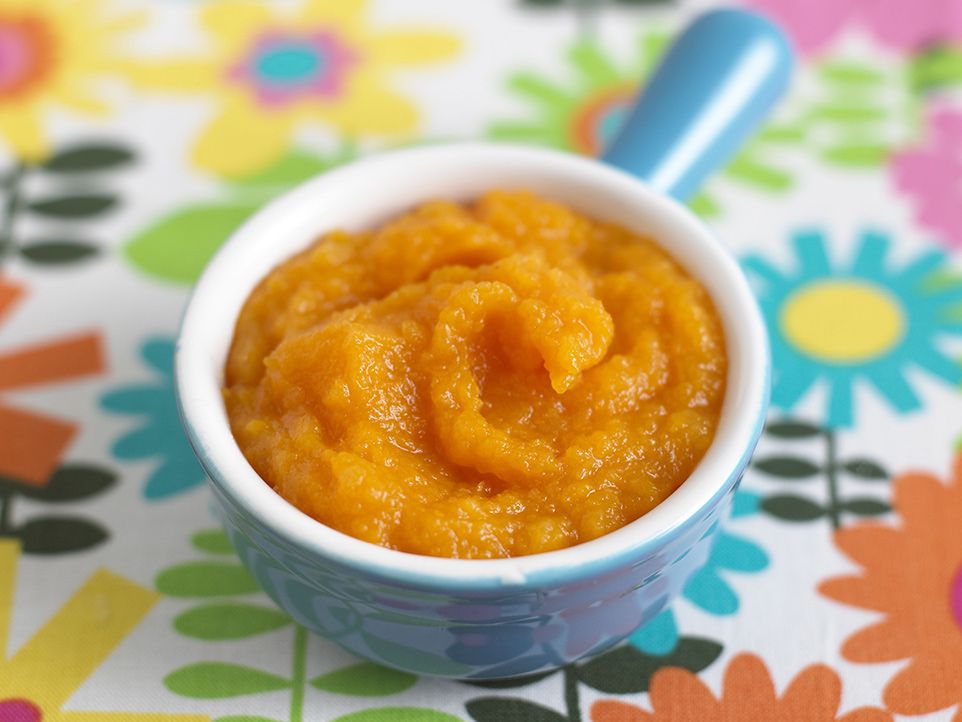 However, in this case, the opinions of experts differ. Some believe that such therapy is safe for everyone, others - each patient must be approached individually. Phytoestrogens are herbal substances that are very similar to human hormones. They treat both osteoporosis and other diseases, namely: vasomotor and trophic disorders, coronary heart disease. They also anabolic effect on bone tissue. However, there are drawbacks: an overdose, as well as prolonged treatment with estrogens alone, leads to the development of endometriosis.
However, in this case, the opinions of experts differ. Some believe that such therapy is safe for everyone, others - each patient must be approached individually. Phytoestrogens are herbal substances that are very similar to human hormones. They treat both osteoporosis and other diseases, namely: vasomotor and trophic disorders, coronary heart disease. They also anabolic effect on bone tissue. However, there are drawbacks: an overdose, as well as prolonged treatment with estrogens alone, leads to the development of endometriosis.
Scientists believe that the risk appears only after 10 years of constant use of estrogens, and its degree is small. If progesterone is combined with estrogens, this will reduce the development of cancer, but it may also reduce the effect of estrogens. The appointment of treatment in the form of hormone therapy entails many negative consequences. In particular, it affects blood clotting. In this regard, this treatment is undesirable for patients with diabetes mellitus, with a violation of the outflow of bile, various liver diseases.
Most doctors refuse to prescribe such treatment, as it increases responsibility. In each situation, you should evaluate all the benefits, take into account contraindications, try to find drugs and medications. This type of treatment is only allowed for responsible and punctual patients, as you should constantly monitor blood clotting and liver function, regularly visit a mammologist and gynecologist, and do ultrasound.
A large amount of ascorbigen and sulforaphane is found in the following plants: broccoli, Brussels sprouts, cauliflower. By using these products, you can reduce the risk of developing oncology of the uterus, lungs, ovaries, mammary glands, prostate, and intestines. It is from the extract from broccoli that Indole 3 carbinol NSP is created. Due to soda, coupled with silicon, soft polishing, whitening and cleaning of the tooth surface is achieved. Silicon dioxide is a colorless substance that helps to quickly and easily remove stains on teeth.
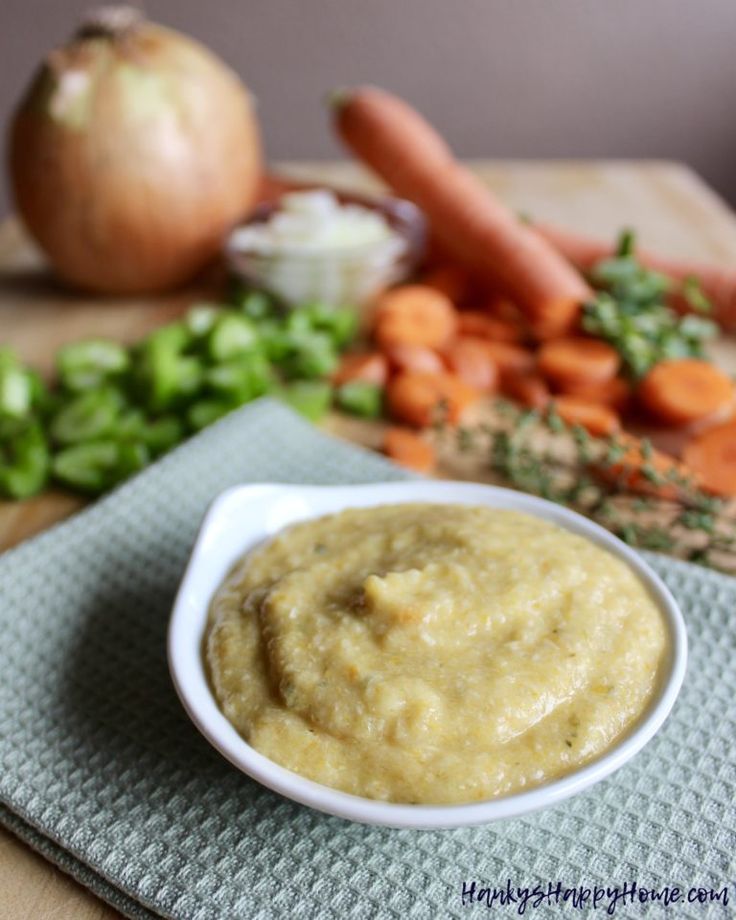
Wild Yam itself is not a source of hormones, but progesterone is. Women in Latin America used it as a contraceptive and with a high chance of miscarriage. Unfortunately, in our time, women during pregnancy increase the risks of carrying a child. Also, information was obtained on the positive effect of wild yam on maintaining pregnancy. Western experts also advise yams for toxicosis. However, Russian specialists currently lack such experience.
This root has many medicinal properties . Knowledgeable people often make themselves an infusion for heart disease. It supports the body's immune system, significantly reduces the amount of cholesterol and lipids in the vessels, restores coronary blood flow, eliminates headaches, tachycardia, improves vision, hearing, prevents tinnitus, has a positive result in the treatment of heart disease, blood vessels and various autoimmune diseases. In addition, it helps to recover from a stroke, heart attack, gout, rheumatoid arthritis, disruption of the hypothalamus and pituitary gland, adrenal glands, and ovaries.






